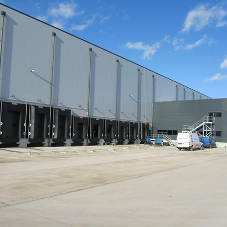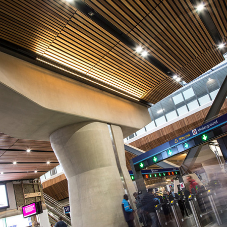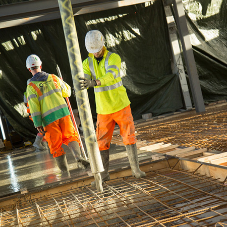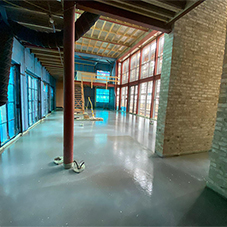Client
Environment Agency
Contractor
BAM Nuttall
Location type
River flood defence
The challenge
In a UK first, BAM, the Environment Agency and Tarmac have successfully trialled the use of two low carbon concrete mixes in permanent works at the Hexham Flood Alleviation Scheme. A duo of ultra-low carbon concretes, developed by Tarmac to new specifications and compressive strength class C32/40, now form the base and walls of a new flood defence structure designed to protect the town and mitigate against flood damage. The trial has been delivered and funded by the Environment Agency’s Collaborative Delivery Framework Hub A, a collaboration between the Environment Agency, Arup, and BAM, as part of a wider project to deliver flood defence schemes across North East England.
Tarmac's solution
One of the new concretes in use by Tarmac was a Portland Limestone Ternary cement C VI, brought in by a new cement standard BS EN 197-5. This concrete has three cementitious components – cement clinker, ground granulated blast furnace slag (GGBS) and up to 20 per cent of limestone filler to replace some of the GGBS. Compared to a standard CEM I, this low carbon mix offered a 64 per cent reduction to 119kg/m3 CO₂e per cubic metre of concrete delivered to site. The second new concrete was an Alkali Activated Cementitious Material (AACM) with over 95 per cent GGBS as the cementitious component. Standards are still being developed for AACM products. This mix offered a 70 per cent reduction to 100kg/m³ CO₂e compared to a standard CEM I. Both mixes were tested for fresh and hardened properties as well as a number of longer-term durability tests.
Results and benefits
Achieving up to 70% reduction in CO₂e, while delivering on the target performance criteria required by the client’s specification, represented a major achievement for the delivery of this project and future best practice. With sustainability a primary consideration, the carbon footprint of the new concrete has been calculated using the BSI PAS2080 specification – a method for assessing the life cycle greenhouse gas (GHG) emissions of concrete. In the UK, cement, a critical component of concrete, produces an average of 1.5 per cent of emissions, with innovation and investment in efficient plant and fuel switching to waste biomass and road tyres making an important contribution to lowering emissions. Concrete footprints are lowered further by replacing some of the cement with secondary cementitious materials such as fly ash, GGBS and now limestone fillers.
Low carbon concrete for Hexham Flood Alleviation Scheme
Products by this Company










